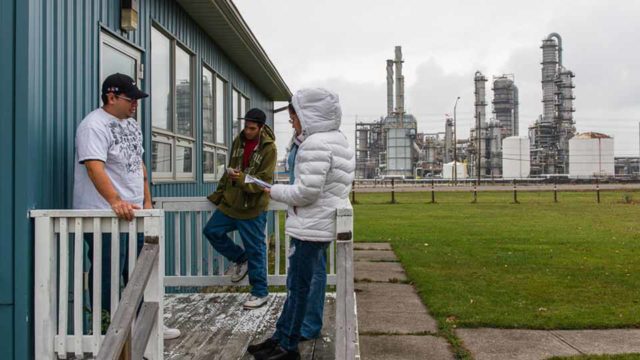After more than a decade of development and public consultation, Ontario’s health-based air quality standard for benzene is set to become law on July 1, 2016. But if some of the province’s largest benzene emitters have their way, the new law may not apply to them.
Benzene is a highly toxic air pollutant that is hazardous to human health at any level. It can cause leukemia, and it is associated with other cancers, including myeloma and non-Hodgkin’s lymphoma.
Benzene is also very common — it is emitted by cars, gas stations, steel mills and other industrial activities. It is also found in crude oil and petroleum products and is used to make a wide variety of products, like plastics, nylon , latex, resin, pesticides, pharmaceuticals and detergents.
So it is encouraging that Ontario‘s health-based air quality standard for this pollutant is finally going to become law.
But as we count down to July 1, Ontario’s Ministry of the Environment and Climate Change is working to accommodate a request from two of the province’s largest industrial benzene emitters – the petroleum refining and petrochemical manufacturing industries.
These industries want to develop a special “technical standard” for benzene, which would exempt some emitters from the air quality standard if they meet certain technological, monitoring and reporting requirements. In short: these industries want to play by their own set of rules.
Why? Industry representatives have complained that meeting the new standard would be economically challenging for these industries.
The health-based air quality standard
The benzene air quality standard was developed under Ontario’s new air pollution laws. Under these laws, standards are set after public consultation, based on science, and meant to protect human health and the environment.
The benzene air quality standard is a good example of this approach. The science is clear: benzene causes cancer and is hazardous to human health, and the air quality standard is designed to minimize these risks.
This is especially important in Aamjiwnaang First Nation and other communities near Sarnia’s Chemical Valley — an area home to a cluster of major industrial facilities, including most of Ontario’s petroleum refining and petrochemical manufacturing facilities.
Benzene levels in the air in Aamjiwnaang are already alarmingly high, so significant action to reduce benzene levels is necessary and overdue. The new benzene air quality standard could be an important tool to prompt such action by petroleum refineries and petrochemical plants.
That is why it is so disappointing that the Ministry is considering letting petroleum refineries and petrochemical plants continue to emit levels of benzene that exceed the health-based standard.
The technical benzene standard
If approved, a technical standard could delay critical decreases in benzene levels because they do not set any numeric limit on benzene levels and most of their requirements would not kick in until several years from now. As sector-wide standards, the technical standards also miss a golden opportunity to make sure that the petroleum refining and petrochemical industries address the cumulative, industry-wide effects of benzene pollution.
In the bigger picture, if the technical standards are finalized as is, it could set a concerning precedent. When the law was changed to allow for technical standards, the Ministry explained them as a way to limit the burden of modelling and monitoring emissions for a large number of small- and mid-sized industrial facilities. For small facilities with minimal emissions, this makes some sense. But the proposed benzene standards are a completely different matter. Now, a small number of very large, sophisticated industrial actors — some of the biggest benzene emitters in the province — are asking for permission to put costs considerations above human health protection.
This is unacceptable, and it raises serious questions about other environmental standards in Ontario.
For example, Ontario has committed to reviewing its outdated sulphur dioxide standard. Like benzene, sulphur dioxide is a dangerous pollutant that is known to pose serious threats to human health. And as with benzene, the people of Aamjiwnaang and Chemical Valley are unfairly impacted by this hazardous contaminant.
If the Ministry approves the benzene standards, it will raise serious questions about how effective this review will be. Will major polluters actually be held to a new standard once it is set? Or will the Ministry carve out exemptions from the new standard because protecting human health isn’t cost-effective for polluters?
Advocating for better air quality
We have worked with our clients Ron Plain and Ada Lockridge, two Aamjiwnaang community members, for many years to advocate for better air quality in Aamjiwnaang and across Ontario. And in the face of these proposed technical standards, we aren’t slowing down now.
Last week, we helped Ron and Ada prepare and submit comments to the Ministry expressing their disappointment over the proposed technical standards. Among their many concerns is the fact that the Ministry has not explained the impacts current benzene levels are having on human health in Aamjiwnaang, or the community health implications the technical standards could have in the future. In fact, it’s not clear from the public consultation documents that the Ministry has considered the health impacts of the proposed technical standards at all.
The technical standards aren’t finalized yet, and we are committed to continuing to work with Ron and Ada to push the Ministry to address these serious problems.
We cannot let industry use technical standards as an excuse to continue business – and emissions – as usual. The risks to human health are too high.




